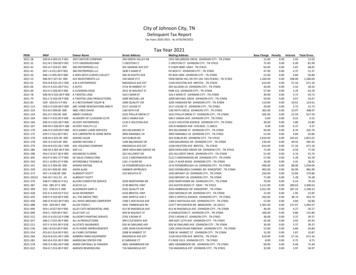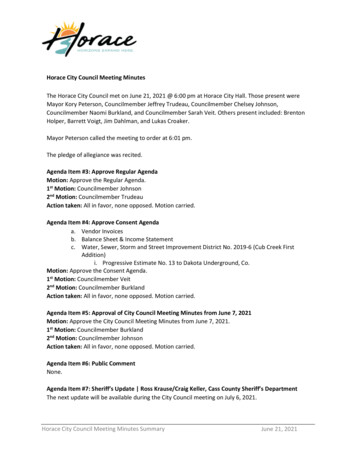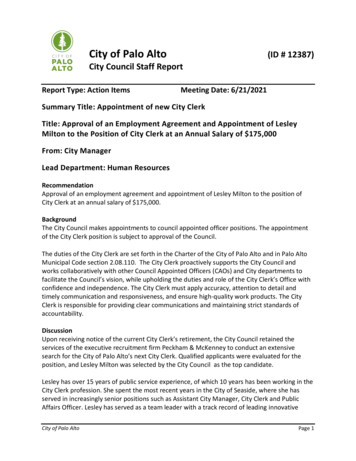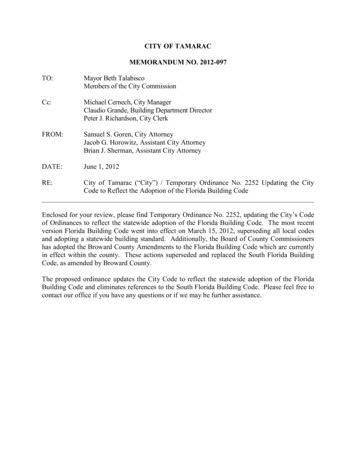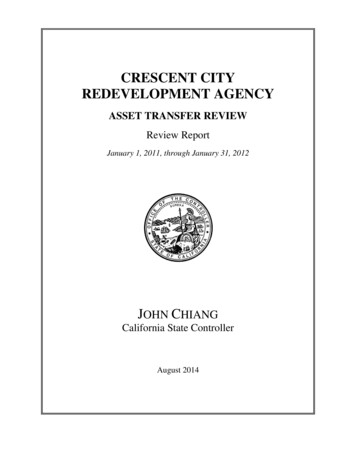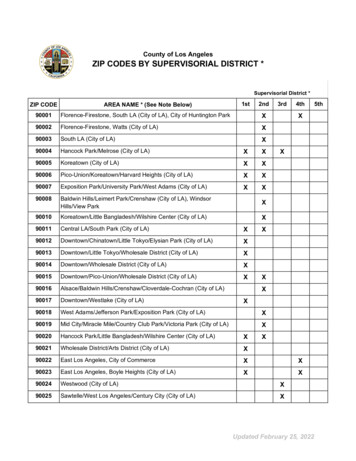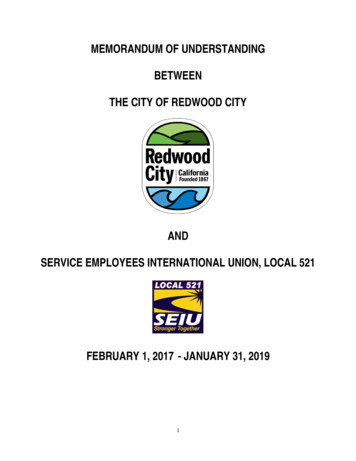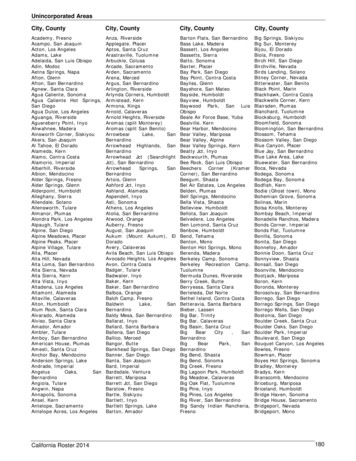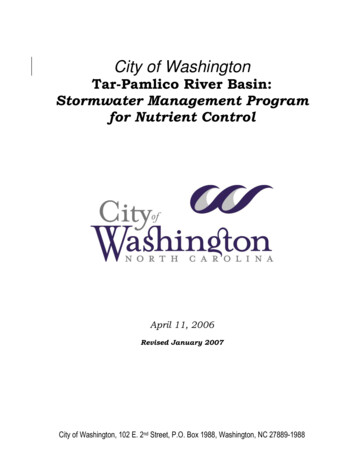
Transcription
City of WashingtonTar-Pamlico River Basin:Stormwater Management Programfor Nutrient ControlApril 11, 2006Revised January 2007City of Washington, 102 E. 2nd Street, P.O. Box 1988, Washington, NC 27889-1988
Table of Contents1.2.3.Introduction1-A. Purpose of the Tar-Pamlico Stormwater Rule1-B. Requirements of the Tar-Pamlico Stormwater RuleNew Development, Redevelopment, Expansions and/or Improvements2-A. Requirements in the Rule2-B. Protecting Riparian Areas on Development2-C. Calculating Nutrient Export from New Development, Expansions, &Improvements2-D. BMPs for Reducing Nitrogen and Phosphorus2-E. Calculating Peak Runoff2-F. Offsite Partial Offset Option2-G. Offset Payment Option2-H. BMP Maintenance2-I. Land Use Planning Provisions57912131515Illegal Discharges3-A. Requirements in the Rule3-B. What is an Illegal Discharge?3-C. Establishing Legal Authority3-D. Collecting Jurisdiction-Wide Information3-E. Mapping and Field Screening in High Priority Areas3-F. Identifying and Removing Illegal Discharges3-G. Preventing Discharges and Establishing a Hotline3-H. Implementation Schedule17171818192122234. Retrofit Locations4-A. Requirements in the Rule4-B. Approach for Meeting Requirements4-C. Data Collection and Notification4-D. Mapping Requirements5.6.124424242425Public Education5-A. Requirements in the Rule5-B. Public Education Action Plan2626Reporting Requirements6-A. New Development Review/Approval6-B. Illegal Discharges6-C. Retrofit Locations6-D. Public Education27272828City of WashingtonStormwater Management Program for Nutrient Controli
Figure / TablesTable 2BMP Types, TN and TP Removal Rates, and Design Standards8Table 3aAllowable Discharges to the Stormwater Collection System17Table 3bFigure 3Discharges Not Allowed to the Stormwater Collection SystemField Screening Process1720Table 3cField Screening Report Information21Table 3dImplementation Schedule for Addressing Illegal Discharges23Table 4Retrofit Opportunity Table for the City of Washington, NC25Table 6Annual Reporting Requirements for Illegal Discharges27AppendicesAppendix A15A NCAC 2B .0258 Tar-Pamlico River Basin - Nutrient SensitiveWaters Management Strategy: Basinwide Stormwater RequirementsAppendix BExport Calculation Worksheets and Supporting InformationAppendix CLand Use Planning and Design TechniquesAppendix DExample Stormwater Maintenance AgreementAppendix EIllicit Discharge Screening Report FormsAppendix FPublic Education Action Report and PlanAppendix GOffset Payments Calculations and DefinitionsAppendix HStormwater Permit ApplicationCity of WashingtonStormwater Management Program for Nutrient Controlii
1. IntroductionIn accordance with stormwater rule 15A NCAC 2B .0258 Tar-Pamlico River Basin-NutrientSensitive Waters Management Strategy: Basinwide Stormwater Requirements, hereafterreferred to as the “Rule”, the City of Washington is required to develop a local stormwaterprogram to comply with the substantive requirements of the Rule. This document isintended to satisfy the substantive requirements of the Rule.1-A. Purpose of the Tar-Pamlico Stormwater RuleThe Tar-Pamlico River Basin begins in Piedmont North Carolina and extends approximately180 miles through the Coastal Plain to Pamlico Sound. Together, Pamlico Sound andneighboring Albemarle Sound constitute one of the most productive estuarine systems in thecountry. The 5,400 square mile Tar-Pamlico basin is comprised primarily of agriculturaland forest land, and many smaller municipalities. Despite the rural character of the basin, inthe mid-1970’s the Pamlico River estuary began to see increasing frequencies of harmfulalgal blooms, fish kills, and other nutrient-related problems.By the mid-1980’s, the state began to consider actions to control nutrient inputs to theestuary. Those actions have included the following:Phase I: In 1989, the North Carolina Environmental Management Commission designatedthe entire basin “Nutrient Sensitive Waters”. The first phase of management through 1994focused primarily on point sources, establishing an annually decreasing nutrient loading capfor an association of dischargers, and an innovative “trading” program that alloweddischargers to achieve reductions in nutrient loading more cost-effectively.PCS Recycling: In 1992, a phosphate mining company then known as Texas Gulf, which islocated on the Pamlico River estuary, instituted a wastewater recycling system that reducedits phosphorus discharges to the estuary by 93%.Phase II: Modeling of estuary conditions showed that despite the gains made to that point,significant reductions in nitrogen and phosphorus loading were still needed to restore waterquality standards and minimize the recurrence of harmful algal blooms. The second phaseof the nutrient strategy, which runs through 2004, established a biologically based goal of 30percent reduction in nitrogen loading from 1991 levels and holding phosphorus loading at1991 levels. Load reductions were apportioned among point sources and the major nonpointsources. The point sources were given steady annual nitrogen and phosphorus loading caps.A program was designed with the nonpoint sources to achieve the goals through voluntarymeasures. After two years of voluntary implementation, the Commission found insufficientprogress and called for rules for nonpoint sources.Rules: Beginning in 1998, DWQ staff conducted a lengthy public input process to evaluatesource categories and develop rules where needed. Over the course of 2000, theCity of WashingtonStormwater Management Program for Nutrient ControlPage 1
Commission adopted rules for agriculture, fertilizer application across all land uses, urbanstormwater, and rules to protect the nutrient removal functions of existing riparian buffers.These rules were modeled after a similar set of rules recently adopted in the adjacent NeuseRiver Basin. The Neuse rules were given extensive public review and modification, and theTar-Pamlico rules similarly received extensive scrutiny. The resulting rules provideincreased flexibility for the regulated community while maintaining the focus of the nutrientreduction goals.1-B. Requirements of the Tar-Pamlico Stormwater RuleThe Tar-Pamlico Stormwater Rule applies to the local governments with the greatestlikelihood of contributing significant nutrient loads to the Pamlico estuary. The EMC maydesignate additional local governments in the future through rule amendment based oncriteria given in the Rule.The affected local governments sonEdgecombeOxfordFranklinRocky MountNashTarboroPittWashingtonFor these local governments, only their geographic areas that fall within the Tar-PamlicoRiver Basin are subject to the Rule; however, the local government may choose toimplement the Rule, or portions thereof, over their entire jurisdictional area. In subjectcounties, applicable areas are those under the direct jurisdiction of the counties, whichwould not include incorporated cities, towns, or villages within county jurisdictional limits.Cities and counties are encouraged to coordinate to establish implementation responsibilitieswithin municipal extraterritorial jurisdictions. Counties administering developmentregulations by interlocal agreement on behalf of municipalities would implement the Rulewithin only those municipalities that are subject to the Rule. The activities of state entitieswithin subject local governments would be subject to the Rule.The Rule establishes a broad set of objectives for limiting nutrient runoff from urban areas.It then lays out a set of specific elements, described below, that the affected localgovernments must include in their programs. Timeframes for implementation of the Ruleare as follows:April 1, 2001:February 13, 2003:Effective date of the Rule.Target date for approval of the Model Stormwater Program by theEnvironmental Management Commission (modified through EMCapproval from the date of April 1, 2002 established in the Rule).City of WashingtonStormwater Management Program for Nutrient ControlPage 2
February 13, 2004:August 13, 2004:Deadline for submittal of local Stormwater Programs (includingordinances) to the EMC (modified as above).Deadline for local governments to begin implementing localStormwater Programs (modified as above).Following implementation in April 2006, the City of Washington, hereafter referred to asthe “City”, will provide annual progress reports to the EMC that will include nitrogen andphosphorus loading reduction estimates.The elements included in the City’s stormwater management program are:1. New Development, Redevelopment, Expansions and/or ImprovementsReview/Approval. The Rule imposes a 4.0 pounds per acre per year (lb/ac/yr) nitrogen loading limit and a 0.4lb/ac/yr phosphorus loading limit on new development. Proposals that exceed theseperformance standards may partially offset their load increases by treating existingdeveloped areas offsite that drain to the same stream. Other developments may be requiredto meet the 30% reduction goal through site planning and best management practicesNew development must also avoid causing erosion of surface water conveyances. Atminimum, post-development peak flows leaving the site may not exceed pre-developmentfor the 1-year, 24-hour storm event. The City may consider using regional stormwaterfacilities to help meet nutrient loading and attenuation requirements under certaincircumstances.2. Illegal DischargesIllegal discharges are substances deposited in storm sewers (that lead to streams) that shouldinstead be handled as wastewater discharges. Illegal discharges may contain nitrogen. TheCity will implement a program to identify and remove existing illegal discharges and toprevent future illegal discharges.3. Retrofit LocationsThere are a number of funding sources available for water quality retrofit projects, such asthe Clean Water Management Trust Fund and the Wetland Restoration Program that the NCGeneral Assembly has recently established. To assist technical experts, the City willidentify sites and opportunities for retrofitting existing development to reduce total nitrogenand phosphorus loads.4. Public EducationCitizens can reduce the nitrogen pollution coming from their lawns and septic systems ifthey understand the impacts of their actions and respond with appropriate managementmeasures. The City will develop and implement public and developer education programsfor its jurisdictional area.City of WashingtonStormwater Management Program for Nutrient ControlPage 3
2. New Development, Redevelopments,Expansions, and ImprovementsReview/Approval2-A. Requirements in the RuleThe Tar-Pamlico Stormwater Rule (15A NCAC 2B .0258) has the following requirements(see the Rule in Appendix A for complete language) for new development located within theplanning and zoning jurisdiction of the City: The nitrogen load contributed by new development activities is held at 4.0 pounds peracre per year. This is equivalent to 70 percent of the estimated average nitrogen loadcontributed by non-urban areas in the Tar-Pamlico River basin (as defined using 1995LANDSAT data). Similarly, the phosphorus load contributed by new developmentactivities is held at 0.4 pounds per acre per year, which is equivalent to the estimatedaverage phosphorus load contributed by non-urban areas in the basin. TheEnvironmental Management Commission may periodically update these performancestandards based on the availability of new scientific information. Property owners shall have the option of partially offsetting projected nitrogen loads byproviding treatment of existing developed areas off-site that drain to the same stream.However, the total nitrogen loading rate cannot exceed 6.0 pounds per acre per year forresidential development or 10 pounds per acre per year for non-residential development. There is no net increase in peak flow leaving the developed site from thepredevelopment conditions for the 1-year, 24-hour storm. The City will review new development plans to assure compliance with requirements forprotecting and maintaining riparian areas as specified in 15A NCAC 2B .0259.2-B. Protecting Riparian Areas on DevelopmentsThe Tar-Pamlico Riparian Buffer Protection Rule, 15A NCAC 2B .0259, requires the Cityto ensure that riparian areas on developments are protected in accordance with the bufferrule’s provisions. The buffer rule requires that 50-foot riparian buffers be maintained on allsides of intermittent and perennial streams, ponds, lakes and estuarine waters in the basin.The buffer rule provides for certain “allowable” uses within the buffer with DWQ approval,such as road and utility crossings.The City will disapprove any development activity proposed within the first 50 feet adjacentto a waterbody that is shown on either the USGS 7.5 minute topographic map or the NRCS(Natural Resources Conservation Service) Soil Survey map unless the owner can show thatthe activity has been approved by DWQ (NC Department of Environment and NaturalResources, Division of Water Quality). DWQ approval may consist of the following: An on-site determination that surface waters are not present.City of WashingtonStormwater Management Program for Nutrient ControlPage 4
An Authorization Certificate from DWQ for an “allowable” use such as a road crossingor utility line, or for a use that is “allowable with mitigation” along with a Divisionapproved mitigation plan. A table delineating such uses is included in the buffer rule. An opinion from DWQ that vested rights have been established for the proposeddevelopment activity. A letter from DWQ documenting that a variance has been approved for the proposeddevelopment activity.2-C. Calculating N and P Export from New Developments, Expansions,and ImprovementsDefinitionsBuilt-upon area means that portion of a development project that is covered by imperviousor partially impervious cover including buildings, pavement, and gravel area. Slattedwooden decks and the water surface area of pools shall be considered pervious.Land disturbance is defined as grubbing, stump removal, grading, or removal of structures.New Development Described: For the purposes of this program, new development,redevelopment, expansions and/or improvements shall be described to include thefollowing: Any activity that disturbs greater than one acre of land to establish, expand, or replace asingle family or duplex residential development or recreational facility. For individualsingle family residential lots of record that are not part of a larger common plan ofdevelopment or sale, the activity must also result in greater than ten percent built-uponarea. Any activity that disturbs greater than one-half an acre of land to establish, expand, orreplace a multifamily residential development or a commercial, industrial or institutionalfacility. Projects meeting the above criteria that replace or expand existing structures orimprovements and that do not result in a net increase in built-upon area shall not berequired to meet the basinwide average non-urban loading levels. Projects meeting the above criteria that replace or expand existing structures orimprovements and that result in a net increase in built-upon area shall achieve a 30percent reduction in nitrogen loading and no increase in phosphorus loading relative tothe previous development. Such projects may achieve these loads through onsite oroffsite measures or some combination thereof. Multi-family residential, commercial, industrial, and institutional projects maychoose to achieve all of this reduction by providing treatment of off-site developedareas, or by permanently conserving land from future development in conformancewith the City’s approved land conservation plan, as described in Section 2-I.City of WashingtonStormwater Management Program for Nutrient ControlPage 5
New development shall not include agriculture (including intensive livestock operations),mining, or forestry activities.Vesting: All new development projects that have received approval from the City for a sitespecific or phased development plan by April 10, 2006 and that have implemented thatdevelopment in accordance with the City’s vesting provisions shall be exempt from theserequirements. Any plats associated with such development must be recorded within amaximum of five years from the date of development approval. All new developmentprojects that have not received such approval by April 10, 2006 or recorded any platsassociated with such development within five years of the development’s approval shall besubject to the requirements of the City of Washington’s, Stormwater Management Programfor Nutrient Control.Projects that require a state permit, such as landfills, NPDES wastewater discharges, landapplication of residuals and road construction activities shall be considered exempt if a statepermit was issued prior to the effective date of the City’s stormwater program.Calculating N and P Export: (Worksheets can be found in Appendix B or athttp://h2o.enr.state.nc.us/nps/tarpam.htm) The nitrogen and phosphorus export fromeach new development must be calculated. This export will be calculated in pounds per acreper year (lbs/ac/yr). A methodology that may be used to make this calculation is describedhere.It is expected that some values provided in the methodology will be refined over time. TheDWQ plans to provide those refinements to the City on a periodic basis as they areestablished. For example, additional research may lead to refined export values for thevarious urban land covers, particularly rooftop and transportation impervious surface. Also,stormwater management practices are typically in various stages of refinement around thecountry. Several nutrient reducing BMPs are being applied and studied around NorthCarolina toward better designs and more accurate knowledge of long-term nutrient removalefficiencies. The City will incorporate these refinements into its program from time to timeas they are substantiated by the DWQ.For a given project, the methodology calculates a weighted annual load export for bothnitrogen and phosphorus based on event mean concentrations of runoff from different urbanland covers and user-supplied acreages for those land covers. The user chooses BMPs thatreduce the export to the City of Washington’s, Stormwater Management Program forNutrient Control mandated levels. The “Coastal Plain” version of the export calculationspreadsheet developed by the DWQ shall be utilized for export calculations within the City.A residential worksheet is also provided in Appendix B to calculate acreages dedicated todifferent land covers in residential developments where impervious footprints are notshown. One situation not addressed by the methodology is a non-residential subdivisionwhere the impervious surfaces are not shown on the plans at the time of submittal. In thiscase, the property owner will be required to use the worst-case scenario based on zoningCity of WashingtonStormwater Management Program for Nutrient ControlPage 6
restrictions for the areas of impervious surface and managed open space for the type ofdevelopment specified and then apply the methodology.2-D. BMPs for Reducing Nitrogen and PhosphorusNew DevelopmentsThe Rule requires that all new developments achieve a nitrogen export of less than or equalto 4.0 (and a phosphorus export of less than or equal to 0.4) pounds per acre per year. If thedevelopment contributes greater than 4.0 pounds nitrogen (or 0.4 pounds phosphorus), thenthe following options exist.For residential (or commercial or industrial) development: If the computed nitrogen export is greater than 6.0 (or 10.0) lb N/ac/yr, then the ownermust either use on-site BMPs or take part in an approved regional or jurisdiction-widestormwater strategy or some combination of these to lower the nitrogen export to at least6.0 (or 10.0) lb N/ac/yr. The owner may then use one of the following two options toreduce nitrogen from 6.0 (or 10.0) to 4.0 lb N/ac/yr. If the computed nitrogen export is greater than 4.0 lb/ac/yr but less than 6.0 (or 10.0) lbN/ac/yr, then the owner may either:1) Install BMPs onsite or take part in an approved regional or jurisdiction-widestormwater strategy or some combination of these to remove nitrogen down to 4.0lb N/ac/yr; or2) Provide treatment of an offsite developed area that drains to the same stream toachieve the same nitrogen mass loading reduction that would have occurred onsite.3) Utilize offset option as described in Section 2-G. The owner must install BMPs that also achieve a phosphorus export of less than or equalto 0.4 lb P/ac/yr, but may do so through any combination of on-site and offsite measures.RedevelopmentsThe Rule requires that all redevelopments that replace or expand existing structures orimprovements and that result in a net increase in built-upon area shall achieve a 30 percentreduction in nitrogen loading and no increase in phosphorus loading relative to the previousdevelopment. Such projects may achieve these loads through onsite or offsite measures orsome combination thereof.For residential (commercial or industrial) redevelopment: Multi-family residential, commercial, industrial, and institutional projects may choose toachieve all of this reduction by providing treatment of off-site developed areas, or bypermanently conserving land from future development in conformance with the City’sapproved land conservation plan, as described in Section 2-G. If the compound nitrogen export is greater than the 30% reduction of the nitrogenloading relative to the previous development; then the owner may either use an onsiteCity of WashingtonStormwater Management Program for Nutrient ControlPage 7
BMP or take part in an approved regional jurisdiction-wide stormwater strategy or somecombination of these to lower the nitrogen export.As with most resource impacts, an ounce of stormwater prevention is worth a pound of cure.A sound site planning process first considers the ability to achieve the needed reductionsusing site design measures that avoid or minimize runoff to begin with. The accountingmethod in Section 2-C provides credit for site planning practices that reduce nutrientloadings in this manner. These planning measures include reducing, disconnecting, andrerouting impervious surfaces, maximizing time of concentration for stormwater, andprotecting open spaces for infiltration and evapotranspiration. More detail on planningmeasures that reduce hydrologic and nutrient loading is given in Appendix C.Often, structural management practices cannot be avoided. BMP selection is an importantand challenging craft. Available data indicate that most BMPs remove only 20 to 40 percentof total nitrogen or phosphorus on a consistent basis. There are a number of issues toconsider to ensure this sustained performance. It is crucial to consider the issues ofaesthetics, long-term maintenance, safety and reliability in BMP design. All BMPs requireregular maintenance and some have varying performance depending on soil type andseason. The efficiencies provided below and in the load calculation worksheets in AppendixB assume correct sizing and other design per the referenced manuals, and optimumperformance based on regular, effective maintenance as well as proper siting of thepractices.The BMPs available for nutrient reduction and their removal rates based on currentliterature studies are provided in Table 2. These median values are based on a literaturereview conducted by a contractor that updated Neuse nitrogen efficiencies and establishedphosphorus values. Provided in the table are the design standards to be adhered to inpermitting BMP design.The design of best management practices that remove nitrogen and phosphorus fromstormwater is a developing field. Researchers throughout the country, particularly in theSoutheast, are conducting studies to identify and refine effective means of controllingnitrogen and phosphorus. As stated in Section 2-C, the DWQ plans to provide refinementsin the stated BMP removal efficiencies to the City on a periodic basis as they aresubstantiated.Table 2: BMP Types, TN and TP Removal Rates, and Design StandardsWet detention pondsConstructed wetlandsTN RemovalRate perLiteratureReview25%40%TP RemovalRate perLiteratureReview40%35%Restored riparian buffers30%30%Grass SwalesVegetated filter stripswith level spreaderBioretention (rain gardens)20%20%30%30%40%35%BMP TypeCity of WashingtonStormwater Management Program for Nutrient ControlAppropriate Design StandardsNC Design ManualNC Design ManualTar-Pamlico Riparian Buffer Rule(15A NCAC 2B .0259)NC Design ManualNC Design Manual and other literatureinformationNC Design ManualPage 8
Sand FiltersProprietary BMPsOther BMPs35%VariesVaries45%VariesVariesNC Design ManualPer manufacturer subject to DWQ approvalSubject to DWQ approvalThe North Carolina Department of Environment and Natural Resources, Division of WaterQuality, Water Quality Section’s Stormwater Best Management Practices, April 1999, canbe accessed and downloaded from the DWQ Stormwater Unit’s web page athttp://h2o.enr.state.nc.us/su/stormwater.html or obtained by contacting the Stormwater Unit at 919733-5083 ext. 545.Multiple BMPs: The worksheet provides calculation space for the case where more thanone BMP is installed in series on a development. It determines the removal rate throughserial rather than additive calculations. This is important to understand in projects where theautomated worksheet is not used to estimate the effect of multiple BMPs.As an example, if a wet detention pond discharges through a restored riparian buffer, thenthe removal rate shall be estimated to be 47.5 percent, determined as follows. The pondremoves 25 percent of the influent nitrogen mass and discharges 75 percent to the buffer.The buffer then removes 30 percent of the remaining 75 percent of the original nitrogenamount that discharged from the pond, or 22.5 percent of the original influent amount. Thesum of 25 and 22.5 is 47.5. The removal rate is NOT 25 percent plus 30 percent.Assigning Values to Pervious Cover: Large-lot residential development may involvesubstantial open space that, at least initially, may remain in an undisturbed wooded orreforesting condition. While it may seem logical to enter this acreage as wooded pervious,without conservation easements or some other mechanism for ensuring protection of theseareas, the City has no control over their eventual condition. Thus, unless specific protectioninstruments, such as conservation easements, are established and provided in thedevelopment application or by the City, lot areas shall be assigned the lawn/landscapemanaged pervious export rate. The worksheet will do this automatically.Riparian buffers protected under the Tar-Pamlico Riparian Buffer Protection rule, 15ANCAC 2B .0259, are divided into two zones, moving landward from the surface water, thatare afforded different levels of protection. Zone 1, the first 30 feet, is to remain essentiallyundisturbed, while zone 2, the outer 20 feet, must be vegetated but may be managed incertain ways. Refer to the Tar-Pamlico Riparian Buffer Protection rule, 15A NCAC 2B.0259, for the measurement method in determining these two zones. The user shall enter theacreage in zone 1 into the worksheet as wooded pervious, while zone 2 acreage shall beentered as managed pervious (lawn/landscape).2-E. Calculating Peak RunoffThe Tar-Pamlico Stormwater Rule requires that development not cause erosion of surfacewater conveyances. At a minimum, development shall not result in a net increase in peakflow leaving the site from pre-development conditions for the 1-year, 24-hour storm event.A number of Neuse local governments sought to use the 2-year rather than the 1-year stormCity of WashingtonStormwater Management Program for Nutrient ControlPage 9
as the design storm for peak flow control given that the 2-year storm is more consistent withcurrent hydrologic modeling methodologies.The main reason that the Rule requires a 1-year design storm for peak flow control is toprotect stream channels from erosion. Development on land causes many changes instormwater hydrology. One of the major causes of streambank erosion in urban streams isthe increase in the frequency of the bankfull-flooding event. The bankfull-flooding eventgenerally occurs at approximately a 1.5-year frequency. The Tar-Pamlico Stormwater Rulerequires control of the 1-year storm to predevelopment levels to insure that the rate ofrelease will be below bankfull and therefore less erosive to the stream channel. Releasingthe 2-year storm at predevelopment levels would likely have the effect of increasing thefrequency of a storm that is just a bit larger than the most erosive storm.Protecting streambanks from erosion is a crucial part of the overall Tar-Pamlico NutrientSensitive Waters Management Strategy. Riparian buffers are protected under this programbecause in most situations they are effective at removing nitrogen resulting from nonpointsource pollution. The use of nitrogen reducing BMPs on new development does not obviatethe need to maintain valuable riparian buffers.In the Neuse process, DWQ staff devised a strategy, which is incorporated here, to allow useof the 2-year design storm while also providing a similar level of protection for streambanksas the use of the 1-year design storm. The strategy gives the City the option of using the 2year storm as the design storm for peak flow control; however, requiring that it be controlledto the pre-development levels of the 1-year storm. This can be done by computing the peakflow associated with the 2-year storm for pre-development conditions and then reducing itby an appropriate percentage to reflect the difference between the 1-year and 2-year stormpeak flows. The City will allow either of the following two options to calculate the peakrunoff.Option 1: Use the 1-year Design StormThe U
City of Washington, 102 E. 2nd Street, P.O. Box 1988, Washington, NC 27889-1988. City of Washington Stormwater Management Program for Nutrient Control i Table of Contents 1. Introduction 1-A. Purpose of the Tar-Pamlico Stormwater Rule 1 . Tar-Pamlico rules similarly received extensive scrutiny. The resulting rules provide
